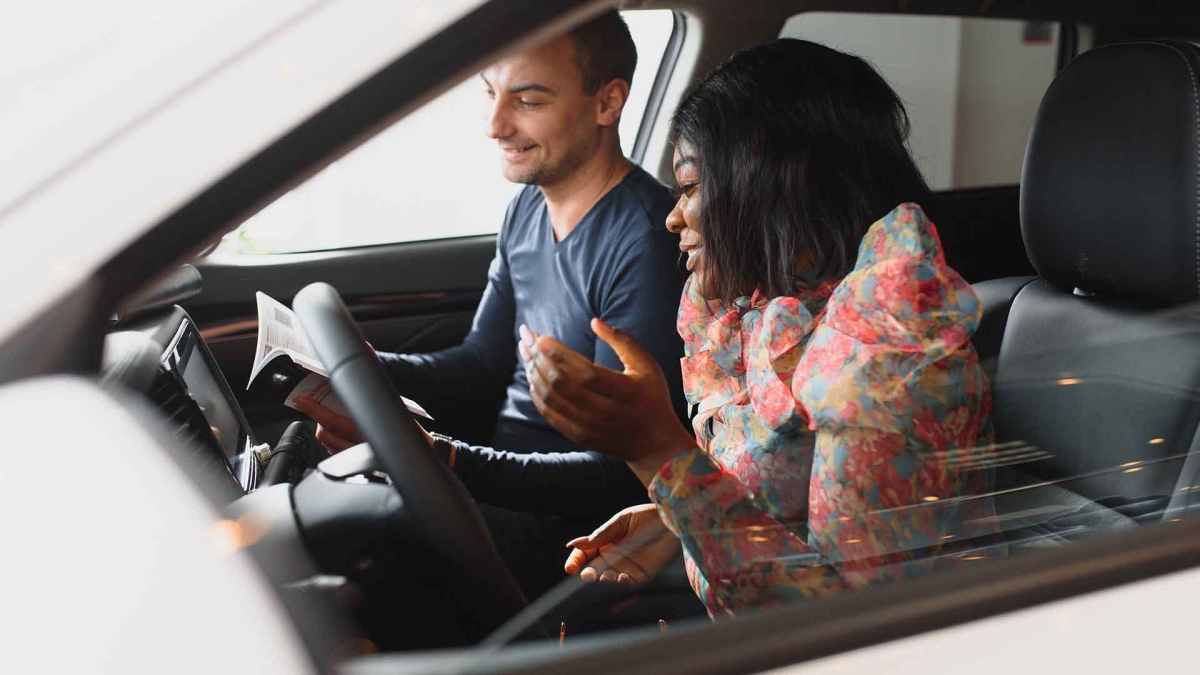How to Get a Driving License in Germany: A Guide for Foreigners
- How to Get a Driving License in Germany: A Guide for Foreigners
- Driving License Test Languages in Germany
- Step-by-Step Process to Get a Driving License in Germany
- German Driving License Theory Test
- Practical Driving Test in Germany
- Manual vs. Automatic Driving Licenses
- Driving License Validity and Renewal
- Foreign Licenses: Do You Need a German License?
- Vehicle Options for the Practical Test
- Costs of Getting a Driving License in Germany
- Is Getting a Driving License in Poland or Neighboring Countries Worth It?
- Tips to Pass the Driving Tests
- FAQ: Driver License in Germany
- How do I get a driver's license in Germany?
- How much does it cost to get a driving license in Germany?
- Is it difficult to get a driving license in Germany?
- Can I take a German practical driving test in English?
- How many mistakes are allowed on a driving test in Germany?
- How long is the German driving test?
- How much are driving lessons in Germany?
- What is the pass rate for the driving test in Germany?
- What is the requirement for driving in Germany?
- How can I pass my driving theory test in Germany?
- Is a foreign driving license valid in Germany?
- How many points are in a German driving license?
- How many practical lessons are there for driving in Germany?
- What is the requirement for driving in Germany?
- Can I get an international driver's license in Germany?
Obtaining a driving license (Führerschein) in Germany is an essential step for anyone planning to drive legally. This guide comprehensively explains the entire process, including available languages for the tests, sample questions, differences between manual and automatic licenses, costs, rules for foreign licenses, practical test vehicle options, validity periods, and renewal requirements.
Driving License Test Languages in Germany
The theoretical test is available in multiple languages, making it accessible to non-German speakers. The available languages include:
- German
- English
- French
- Turkish
- Spanish
- Russian
- Polish
- Arabic
- Italian
- Portuguese
The practical test is conducted in German, but you can hire a translator or find a bilingual driving instructor to assist during the examination.
Step-by-Step Process to Get a Driving License in Germany
1. Enroll in a Driving School (Fahrschule)
Attending a certified driving school is mandatory. They provide both theoretical and practical training to prepare you for the tests.
2. Complete First Aid Training and Eye Test
- First Aid Course (Erste-Hilfe-Kurs): This one-day course costs €30–€50 and covers basic emergency response techniques.
- Eye Test (Sehtest): Conducted at opticians or specialized centers, costing €6–€10.
3. Apply at the Local Licensing Office
Submit the following documents at the Führerscheinstelle (licensing office):
- Valid ID or passport.
- Certificates from the First Aid course and eye test.
- Proof of enrollment in a driving school.
- Biometric photo.
Once your application is approved, you can proceed to the tests.
German Driving License Theory Test
The theoretical test evaluates your knowledge of road signs, traffic rules, and safe driving practices.
Test Format
- Number of Questions: 30 multiple-choice questions.
- Time Limit: 45 minutes.
- Error Points: A maximum of 10 error points is allowed to pass.
Points System
Each question is weighted based on its difficulty:
- 2 Points: Simple questions.
- 5 Points: Critical safety questions.
If your total error points exceed 10, you fail.
Sample Theory Test Questions
- What does this road sign mean?
- a) No overtaking
- b) End of speed restriction
- c) Priority road
Correct Answer: c) Priority road
- You see a flashing yellow pedestrian crossing light. What do you do?
- a) Speed up.
- b) Slow down and stop if necessary.
- c) Ignore pedestrians.
Correct Answer: b) Slow down and stop if necessary
Cost of the Theory Test
- Test Fee: €20–€40.
- Theory Classes: €200–€400 (often included in driving school fees).
Useful Apps for Theory Test Preparation
- Fahren Lernen App: Offers official test questions in multiple languages with feedback.
- iTheorie Führerschein: Includes practice exams and video-based questions.
- ADAC Führerschein Trainer: Developed by ADAC, this app provides accurate mock tests and tips.
- Führerschein 2024: Comprehensive app with visual learning tools.
Practical Driving Test in Germany
The practical test assesses your ability to drive safely in real-world conditions.
Test Format
- Duration: 30–45 minutes.
- Skills Assessed:
- Parking (parallel and reverse).
- Navigating intersections and following right-of-way rules.
- Merging onto Autobahns.
- Emergency braking.
Sample Practical Test Scenarios
- Scenario: You’re asked to merge onto a busy Autobahn.
Action: Signal early, accelerate smoothly, and merge without disrupting traffic. - Scenario: You approach a cyclist while making a right turn.
Action: Yield to the cyclist and complete your turn only when safe. - Scenario: You must parallel park in a tight space.
Action: Signal, align with the car in front, and reverse carefully into the spot.
Error Threshold
- Major Errors: Disobeying traffic laws (e.g., running a red light) results in immediate failure.
- Minor Errors: A few minor mistakes (e.g., hesitation) may be acceptable but repeated errors can lead to failure.
Cost of the Practical Test
- Test Fee: €90–€120.
- Driving Lessons: €30–€50 per session.
Manual vs. Automatic Driving Licenses
Differences Between Manual and Automatic Licenses
- Manual License: Allows you to drive both manual and automatic cars.
- Automatic License: Restricts you to automatic cars.
Should You Choose Manual or Automatic?
- A manual license is more versatile and preferred if you might drive manual cars.
- Automatic licenses are easier to obtain as driving automatic cars simplifies gear control.
Upgrading From Automatic to Manual
You must pass an additional practical test using a manual car. No theory retest is required.
Driving License Validity and Renewal
How Long Is a German Driving License Valid?
All German driving licenses issued after 2013 are valid for 15 years.
How to Renew a Driving License in Germany
- Submit a new biometric photo and valid ID to the licensing office.
- No theoretical or practical test is required for renewal.
Foreign Licenses: Do You Need a German License?
Driving With a Foreign License
- EU/EEA Licenses: Fully recognized in Germany. No conversion required.
- Non-EU Licenses: Valid for up to six months. After this, a German license is mandatory.
Converting a Foreign License
- Some countries (e.g., USA, Canada, Australia) have agreements with Germany, allowing partial conversion.
- Other countries may require the full driving school process.
Vehicle Options for the Practical Test
Do You Need to Bring Your Own Car?
- Driving schools typically provide vehicles for the test. These cars are equipped with dual controls for safety.
Can You Use Your Own Car?
Yes, but it must:
- Be insured and roadworthy.
- Have dual controls (additional brake pedal for the examiner).
Most private cars don’t meet these requirements, so using a driving school car is the norm.
Costs of Getting a Driving License in Germany
Here’s an approximate cost breakdown:
- Driving School Enrollment: €1,000–€2,500.
- Theory Test Fee: €20–€40.
- Practical Test Fee: €90–€120.
- First Aid Course: €30–€50.
- Eye Test: €6–€10.
- Application Fee: €40–€70.
- Total Estimated Cost: €1,500–€3,000.
Is Getting a Driving License in Poland or Neighboring Countries Worth It?
Advantages
- Lower Costs: Polish licenses typically cost under €1,000.
- Simpler Tests: Many consider the tests less challenging than in Germany.
- Faster Process: The process may take less time if you’re well-prepared.
Disadvantages
- Residency Rules: You must reside in Poland for at least 185 days (6 months) to qualify.
- Insurance Issues: German insurers may charge higher premiums for licenses obtained abroad.
- Legal Concerns: German authorities might question the validity of foreign licenses if residency rules are not followed.
Verdict
While it can be cheaper and faster, obtaining a license abroad may lead to complications for long-term German residents.
Tips to Pass the Driving Tests
- Study Regularly: Use apps to simulate the theory test.
- Practice on German Roads: Familiarize yourself with Autobahn driving and parking.
- Take Extra Lessons: Focus on areas you find challenging, such as merging or emergency braking.
Getting a driving license in Germany requires effort, time, and money, but it prepares you for the country’s strict road safety standards. By understanding the process, using helpful apps, and preparing thoroughly, you can navigate the requirements successfully and enjoy the freedom of driving in Germany.
FAQ: Driver License in Germany
How do I get a driver’s license in Germany?
To obtain a driver’s license in Germany, you need to:
Complete a first-aid course: This is mandatory.
Pass a vision test: A local optician or driving school can conduct this.
Enroll in a driving school: Take theoretical and practical lessons.
Pass the theory exam: This includes questions about traffic rules, signs, and regulations.
Pass the practical driving test: Demonstrate your driving skills to an examiner.
How much does it cost to get a driving license in Germany?
The total cost to obtain a driving license in Germany typically ranges from €1,500 to €3000. This includes costs for driving lessons, examination fees, and other required courses. Prices can vary depending on the driving school and the number of lessons needed.
Is it difficult to get a driving license in Germany?
The process to obtain a driving license in Germany can be challenging, especially for the theory and practical tests, which are rigorous. However, with proper preparation and practice, many applicants successfully pass the tests.
Can I take a German practical driving test in English?
Yes, you can take the practical driving test in English, but you must inform your driving school and the local licensing authority in advance. Not all examiners may be fluent in English, so it’s good to check beforehand.
How many mistakes are allowed on a driving test in Germany?
During the practical driving test in Germany, you are allowed a few minor mistakes, but any major errors or unsafe driving can lead to immediate failure. The exact number of minor mistakes varies by examiner, but generally, keeping mistakes to a minimum is crucial.
How long is the German driving test?
The practical driving test in Germany typically lasts about 40 minutes. This includes various driving situations and maneuvers, allowing the examiner to assess your driving skills thoroughly.
How much are driving lessons in Germany?
Driving lessons in Germany generally cost between €50 to €70 per hour, depending on the driving school and location. Some schools offer packages that include a set number of lessons at a discounted rate.
What is the pass rate for the driving test in Germany?
The pass rate for the practical driving test in Germany varies, but it’s generally around 60% to 70% for first-time candidates. Thorough preparation and practice can help improve your chances of passing.
What is the requirement for driving in Germany?
To drive in Germany, you must have a valid driver’s license, be at least 18 years old (for a standard car license), and comply with insurance and registration requirements. If you’re a foreigner, you may need to exchange your license for a German one after a certain period.
How can I pass my driving theory test in Germany?
To pass your driving theory test in Germany, study the official learning materials, take practice tests, and familiarize yourself with traffic rules, signs, and regulations. Many driving schools offer courses specifically designed to help you prepare for the test.
Is a foreign driving license valid in Germany?
Yes, a foreign driving license is valid in Germany for a limited period, typically up to six months. After this period, you may need to exchange it for a German license, depending on your home country.
How many points are in a German driving license?
The German driving license operates on a points system, where you start with zero points. Minor traffic violations add points to your record, while accumulating eight points can result in losing your driving license.
How many practical lessons are there for driving in Germany?
The number of practical lessons required varies by individual but generally includes at least 12 hours of special driving lessons (such as night driving, highway driving, and driving in adverse conditions) in addition to regular practice lessons.
What is the requirement for driving in Germany?
To drive in Germany, you must have a valid driver’s license, be at least 18 years old for a standard car license, have valid insurance, and ensure that your vehicle is registered. Familiarity with German traffic laws is also essential.
Can I get an international driver’s license in Germany?
Yes, you can obtain an International Driving Permit (IDP) in Germany if you have a valid German driver’s license. The IDP allows you to drive in other countries, but it is not a standalone license and must be accompanied by your German license.
How informative was this article?
Click on a star to rate it!
We are sorry that this post was not useful for you!
Let us improve this post!
What is missing in the article?















